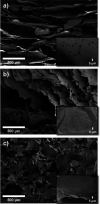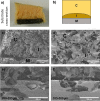Fabrication and Characterization of Bioactive Gelatin-Alginate-Bioactive Glass Composite Coatings on Porous Titanium Substrates
- PMID: 35316017
- PMCID: PMC8990524
- DOI: 10.1021/acsami.2c01241
Fabrication and Characterization of Bioactive Gelatin-Alginate-Bioactive Glass Composite Coatings on Porous Titanium Substrates
Abstract
In this research work, the fabrication of biphasic composite implants has been investigated. Porous, commercially available pure Ti (50 vol % porosity and pore distributions of 100-200, 250-355, and 355-500 μm) has been used as a cortical bone replacement, while different composites based on a polymer blend (gelatin and alginate) and bioactive glass (BG) 45S5 have been applied as a soft layer for cartilage tissues. The microstructure, degradation rates, biofunctionality, and wear behavior of the different composites were analyzed to find the best possible coating. Experiments demonstrated the best micromechanical balance for the substrate containing 200-355 μm size range distribution. In addition, although the coating prepared from alginate presented a lower mass loss, the composite containing 50% alginate and 50% gelatin showed a higher elastic recovery, which entails that this type of coating could replicate the functions of the soft tissue in areas of the joints. Therefore, results revealed that the combinations of porous commercially pure Ti and composites prepared from alginate/gelatin/45S5 BG are candidates for the fabrication of biphasic implants not only for the treatment of osteochondral defects but also potentially for any other diseases affecting simultaneously hard and soft tissues.
Keywords: bioactive coating; biopolymer composites; osteochondral defects; porous titanium; tribomechanical behavior.
Conflict of interest statement
The authors declare no competing financial interest.
Figures














Similar articles
-
Gelatin and Bioactive Glass Composites for Tissue Engineering: A Review.J Funct Biomater. 2022 Dec 31;14(1):23. doi: 10.3390/jfb14010023. J Funct Biomater. 2022. PMID: 36662070 Free PMC article. Review.
-
Biofunctional and Tribomechanical Behavior of Porous Titanium Substrates Coated with a Bioactive Glass Bilayer (45S5-1393).ACS Appl Mater Interfaces. 2020 Jul 8;12(27):30170-30180. doi: 10.1021/acsami.0c07318. Epub 2020 Jun 25. ACS Appl Mater Interfaces. 2020. PMID: 32530265
-
Structure, phases, and mechanical response of Ti-alloy bioactive glass composite coatings.Mater Sci Eng C Mater Biol Appl. 2014 Mar 1;36:261-76. doi: 10.1016/j.msec.2013.12.017. Epub 2013 Dec 14. Mater Sci Eng C Mater Biol Appl. 2014. PMID: 24433912
-
Gelatin functionalised porous titanium alloy implants for orthopaedic applications.Mater Sci Eng C Mater Biol Appl. 2014 Sep;42:396-404. doi: 10.1016/j.msec.2014.05.048. Epub 2014 Jun 2. Mater Sci Eng C Mater Biol Appl. 2014. PMID: 25063133
-
Development of Bioglass/PEEK Composite Coating by Cold Gas Spray for Orthopedic Implants.J Therm Spray Technol. 2022;31(1-2):186-196. doi: 10.1007/s11666-021-01312-w. Epub 2022 Jan 10. J Therm Spray Technol. 2022. PMID: 37520904 Free PMC article. Review.
Cited by
-
Versatile Biodegradable Poly(acrylic acid)-Based Hydrogels Infiltrated in Porous Titanium Implants to Improve the Biofunctional Performance.Biomacromolecules. 2023 Nov 13;24(11):4743-4758. doi: 10.1021/acs.biomac.3c00532. Epub 2023 Sep 7. Biomacromolecules. 2023. PMID: 37677155 Free PMC article.
-
Fabrication of novel nanofiber composed of gelatin/alginate with zirconium oxide NPs regulate orthodontic progression of cartilage degeneration on Wnt/β-catenin signaling axis in MC3T3-E1 cells.Regen Ther. 2024 Feb 2;25:308-319. doi: 10.1016/j.reth.2024.01.004. eCollection 2024 Mar. Regen Ther. 2024. PMID: 38327718 Free PMC article.
-
Gelatin and Bioactive Glass Composites for Tissue Engineering: A Review.J Funct Biomater. 2022 Dec 31;14(1):23. doi: 10.3390/jfb14010023. J Funct Biomater. 2022. PMID: 36662070 Free PMC article. Review.
-
Recent Progress on the Applications of Nanomaterials and Nano-Characterization Techniques in Endodontics: A Review.Materials (Basel). 2022 Jul 22;15(15):5109. doi: 10.3390/ma15155109. Materials (Basel). 2022. PMID: 35897542 Free PMC article. Review.
-
Physicochemical and functional characterization of gelatin edible film incorporated with fucoidan isolated from Sargassum tenerrimum.Food Sci Nutr. 2023 May 3;11(7):4124-4135. doi: 10.1002/fsn3.3402. eCollection 2023 Jul. Food Sci Nutr. 2023. PMID: 37457150 Free PMC article.
References
-
- World Health Organization . Musculoskeletal conditions https://www.who.int/news-room/fact-sheets/detail/musculoskeletal-conditions (accessed May 7, 2021).
-
- Cieza A.; Causey K.; Kamenov K.; Hanson S. W.; Chatterji S.; Vos T. Global Estimates of the Need for Rehabilitation Based on the Global Burden of Disease Study 2019: A Systematic Analysis for the Global Burden of Disease Study 2019. Lancet 2020, 2006.10.1016/S0140-6736(20)32340-0. - DOI - PMC - PubMed
MeSH terms
Substances
LinkOut - more resources
Full Text Sources

